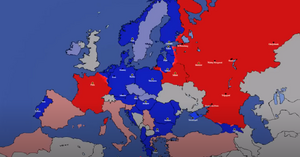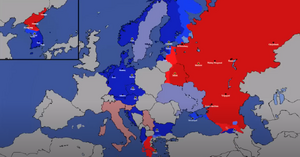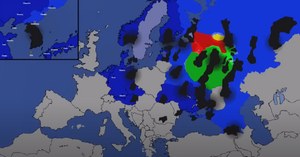World War 2.5: Difference between revisions
mNo edit summary |
mNo edit summary |
||
| (9 intermediate revisions by 2 users not shown) | |||
| Line 1: | Line 1: | ||
World War 2.5 was a large European conflict between CETO, lead by [[4th Reich|Germany]] and against mainly Russia and France.{{ConflictBox|timeline=2032-2035|place=Europe|combatant1=France (2032-2032) | '''World War 2.5''', also known as the '''2nd Interwar''' was a large European conflict between CETO, lead by [[4th Reich|Germany]] and against mainly Russia and France.{{ConflictBox|timeline=2032-2035|place=Europe|combatant1=France (2032-2032) | ||
Wallonia (2032-2032) | Wallonia (2032-2032) | ||
Russian Federation | Russian Federation | ||
| Line 36: | Line 36: | ||
Sweden (2032-2035) | Sweden (2032-2035) | ||
United States (2032) | United States (2032) | ||
Ireland (2032-2033)}} | Ireland (2032-2033)|territory=-France annexes Wallonia | ||
-Russia is balkanized | |||
-Anarchist Athens comes to power in Greece | |||
-Estonia and Latvia unites into Livonia | |||
-The Netherlands annexes Belgium | |||
-Finland annexes Karelia | |||
-Many countries leaves CETO, however Czechia rejoins it|strength1=9 500 000|strength2=7 500 000|casualties1=4 200 000|casualties2=1 400 000}} | |||
''*Military casualties and prior to the nukes.'' | |||
== Background == | |||
==== Instability ==== | |||
After the economical recession of 2029 the [[Old West|old World Order]] was rapidly falling apart. Iran and Syria had recently fell to anachism, America was fighting a guerilla war trying to prevent the same from also happening to Panama, Colombia, Venezuela and Guyana whilst also trying to provide humanitarian aid to the revolution going on in China. Due to these distractions the US had thought it best to leave NATO and withdraw from Europe at least temporarily in order to better take care of the rest of the world, including himself. Him leaving NATO however made a huge dent in the alliance's reputation and many other countries would soon leave it as well, primarily the newly proclaimed rationalist states likes France, Spain and Italy but also isolationist Britain, among other democracies. The remainder of NATO would be renamed to CETO (Central European Treaty Organization) and would be lead by [[4th Reich|Germany]]. | After the economical recession of 2029 the [[Old West|old World Order]] was rapidly falling apart. Iran and Syria had recently fell to anachism, America was fighting a guerilla war trying to prevent the same from also happening to Panama, Colombia, Venezuela and Guyana whilst also trying to provide humanitarian aid to the revolution going on in China. Due to these distractions the US had thought it best to leave NATO and withdraw from Europe at least temporarily in order to better take care of the rest of the world, including himself. Him leaving NATO however made a huge dent in the alliance's reputation and many other countries would soon leave it as well, primarily the newly proclaimed rationalist states likes France, Spain and Italy but also isolationist Britain, among other democracies. The remainder of NATO would be renamed to CETO (Central European Treaty Organization) and would be lead by [[4th Reich|Germany]]. | ||
==== Wallonian Uprising ==== | |||
In late 2031 Wallonia would rise up in southern Belgium, attempting to gain independence. After a few months of fighting the rebels accidentally revealed France to be their sponsor. Given this realization and [[France]]'s over all hostility, [[4th Reich|Germany]] decided to activate Article 5 since [[France]] was essentially attacking a CETO member. | |||
== War == | |||
[[File:Ww2.5.png|thumb|World War 2.5]] | |||
==== Early Grind ==== | |||
After CETO went to war with [[France]], the Russian Federation was quick to capitalize on the situation and declare war on CETO. Russia began a painfully slow advance into the Baltics and into Georgia while [[France]] helped Wallonia manage to secure the rest of southern Belgium before German reinforcements could arrive. Later that year the Anarchists of Athens would once again attempt to rise up in Greece, after having been put down by NATO forces previously back in 2027. As 2032 went on, it would quickly become apparent to everyone that warfare had not changed much since the Ukraine War, and that large scale offensives were subsequently almost impossible to pull off. none of the sides would be able to pull off any significant advances and the war would be a grinding war of attrition, much like the likes of World War 1. And so, on the second of December 2032, [[4th Reich|Germany]] would cook up a plan to hopefully win the war in spite of this. | |||
==== Second Schlieffen Plan ==== | |||
As the plan went, CETO forces would withdraw from Estonia, retreating to a defensive line along the Daugava River in Latvia. This line would be kept until Belarus could siege down Vilnius, at which point CETO would withdraw to a second defensive line along the Polish border. Based on the current rate of the Russian advance, this plan would be able to hold off Russia for the majority of the war. The Eastern Front was to be managed mainly by Poland and Finland. The plan was to hold off long enough for the Russian Federation to collapse. In the meantime Germany, along with most of the CETO forces would launch an offensive into [[France]] propper, with the aim of capturing Paris and knocking [[France]] out of the war like how it was done in World War 2. The plan called for most of CETO's forces to be concentrated in Belgium and with the sheer number advantage they would be able to break through the French line, capitalizing on the French disorganization that would be gained after such an unanticipated successfull offensive and thus continue the blitzkrieg all the way to Paris. Romania, Bulgaria and Albania was to in the meantime overwhelm and defeat the Anarchists of Athens. Considering [[4th Reich|German]] had taken German strategies from both World Wars into account it is possible that this plan might have worked. Nevertheless, [[4th Reich|Germany]]'s plan would never come to fruition as it would be rejected by his allies due to varying reasons. | |||
[[File:Ww2.5 late.png|thumb|January 2034]] | |||
==== Intermarium ==== | |||
Despite most of his allies rather wanting to peace out with the French and let him have Wallonia in order to instead better focus on the Russian threat, the [[4th Reich|Fourth Reich]] would not budge. It wasn't until [[Cinatit The Corruptor|Cinatit]] pulled strings of past trauma that he agreed to peace out with France and in effect send his forces to reinforce the Eastern Front. With these reinforcements, Poland would be able to launch a counter offensive, pushing into Belarus and capturing Kaliningrad. This success would not last however since after having raised conscription Russia would initiate a new offensive in the summer of 2033. Seeing this, Poland would declare a rationalist dictatorship and peace out with the Russians. He would go on to form the Intermarium alliance with Hungary and he would pressure Lithuania into becomming his puppet and he would invade Slovakia. After losing the support from Poland and with CETO forces now rather reinforcing the Finnish front, Estonia and Latvia decided to untie and form [[Livonia]] in hopes of holding out for longer. Other countries like Romania also left the war around this time, giving back the advantage to the anarcho capitalists, on the Balkan Front. | |||
==== Second Russian Revolution ==== | |||
''See more: [[2nd Russian Revolution]]'' | |||
In January of 2034 Russia would face a Chechen uprising which would be the first of many to come. After having put down the rebellion, Russian leader Putin ordered to crush all opposition, which would soon entail a massive crackdown on Russian civilians. There was even rumours to reopen the Gulags for the dissenters. This was too much for the Russian people and the Russian Federation quickly dound himself in the middle of the [[2nd Russian Revolution]], much like [[4th Reich|Germany]] had predicted, two years prior, whilst deceloping the Second Schlieffen Plan. Ukraine would join the war amidst this chaos in hopes of retaking the Dombass. The Balkan Front would soon come to an end, as the Balkan ETO members would leave the alliance and peace out with the Greek anarchist rebels. CETO would not come to intervene much in the Russian civil war, mostly just sending aid to Ukraine, helping to liberate Belarus, Saint Petersburg and Karelia. The remnants of Belgium would come to join the Netherlands after having been devestated by the figting against France. | |||
[[File:Russian apocalypse.png|thumb|Russian Apocalypse]] | |||
==== Russian Apocalypse ==== | |||
''See more: [[Russian Apocalypse]], [[Fallout Campaigns]]'' | |||
On New Year's Eve, Russia would decide to unleash his nuclear arsenal upon CETO but mainly his rebels. This decision would ultimately kill around 75 % of the Russian population and bring about his downfall in late 2035. CETO would leave the war following his death. | |||
Latest revision as of 13:55, 11 January 2025
World War 2.5, also known as the 2nd Interwar was a large European conflict between CETO, lead by Germany and against mainly Russia and France.
| World War 2.5 | |||||
|---|---|---|---|---|---|
| Timeline: 2032-2035 | |||||
|
|||||
| Belligerents | |||||
| France (2032-2032)
Wallonia (2032-2032) Russian Federation Belarus Anarchists of Athens (2032-2034) | Germany
Austria Netherlands Belgium Luxembourg Norway Denmark Finland Canada Livonia Crimea Georgia Czechia (2033-2035) Romania (2032-2033) Moldova (2032-2033) Portugal (2032-2033) Poland (2032-2033) Hungary (2032-2033) Lithuania (2032-2033) Greece (2032-2034) Bulgaria (2032-2034) Croatia (2032-2034) Albania (2032-2034) Ukraine (2034-2035) Japan (2035) |
||||
| Spain (2032)
Morocco (2032) Nations of the Françafrique (2032) Türkiye (2032-2034) Italy (2032-2034) Slovenia (2032-2034) Serbia (2032-2034) | Ukraine (2033-234)
Sweden (2032-2035) United States (2032) Ireland (2032-2033) |
||||
| Strength | |||||
| 9 500 000 | 7 500 000 | ||||
| Casualties and losses | |||||
| 4 200 000 | 1 400 000 | ||||
*Military casualties and prior to the nukes.
Background[edit | edit source]
Instability[edit | edit source]
After the economical recession of 2029 the old World Order was rapidly falling apart. Iran and Syria had recently fell to anachism, America was fighting a guerilla war trying to prevent the same from also happening to Panama, Colombia, Venezuela and Guyana whilst also trying to provide humanitarian aid to the revolution going on in China. Due to these distractions the US had thought it best to leave NATO and withdraw from Europe at least temporarily in order to better take care of the rest of the world, including himself. Him leaving NATO however made a huge dent in the alliance's reputation and many other countries would soon leave it as well, primarily the newly proclaimed rationalist states likes France, Spain and Italy but also isolationist Britain, among other democracies. The remainder of NATO would be renamed to CETO (Central European Treaty Organization) and would be lead by Germany.
Wallonian Uprising[edit | edit source]
In late 2031 Wallonia would rise up in southern Belgium, attempting to gain independence. After a few months of fighting the rebels accidentally revealed France to be their sponsor. Given this realization and France's over all hostility, Germany decided to activate Article 5 since France was essentially attacking a CETO member.
War[edit | edit source]

Early Grind[edit | edit source]
After CETO went to war with France, the Russian Federation was quick to capitalize on the situation and declare war on CETO. Russia began a painfully slow advance into the Baltics and into Georgia while France helped Wallonia manage to secure the rest of southern Belgium before German reinforcements could arrive. Later that year the Anarchists of Athens would once again attempt to rise up in Greece, after having been put down by NATO forces previously back in 2027. As 2032 went on, it would quickly become apparent to everyone that warfare had not changed much since the Ukraine War, and that large scale offensives were subsequently almost impossible to pull off. none of the sides would be able to pull off any significant advances and the war would be a grinding war of attrition, much like the likes of World War 1. And so, on the second of December 2032, Germany would cook up a plan to hopefully win the war in spite of this.
Second Schlieffen Plan[edit | edit source]
As the plan went, CETO forces would withdraw from Estonia, retreating to a defensive line along the Daugava River in Latvia. This line would be kept until Belarus could siege down Vilnius, at which point CETO would withdraw to a second defensive line along the Polish border. Based on the current rate of the Russian advance, this plan would be able to hold off Russia for the majority of the war. The Eastern Front was to be managed mainly by Poland and Finland. The plan was to hold off long enough for the Russian Federation to collapse. In the meantime Germany, along with most of the CETO forces would launch an offensive into France propper, with the aim of capturing Paris and knocking France out of the war like how it was done in World War 2. The plan called for most of CETO's forces to be concentrated in Belgium and with the sheer number advantage they would be able to break through the French line, capitalizing on the French disorganization that would be gained after such an unanticipated successfull offensive and thus continue the blitzkrieg all the way to Paris. Romania, Bulgaria and Albania was to in the meantime overwhelm and defeat the Anarchists of Athens. Considering German had taken German strategies from both World Wars into account it is possible that this plan might have worked. Nevertheless, Germany's plan would never come to fruition as it would be rejected by his allies due to varying reasons.

Intermarium[edit | edit source]
Despite most of his allies rather wanting to peace out with the French and let him have Wallonia in order to instead better focus on the Russian threat, the Fourth Reich would not budge. It wasn't until Cinatit pulled strings of past trauma that he agreed to peace out with France and in effect send his forces to reinforce the Eastern Front. With these reinforcements, Poland would be able to launch a counter offensive, pushing into Belarus and capturing Kaliningrad. This success would not last however since after having raised conscription Russia would initiate a new offensive in the summer of 2033. Seeing this, Poland would declare a rationalist dictatorship and peace out with the Russians. He would go on to form the Intermarium alliance with Hungary and he would pressure Lithuania into becomming his puppet and he would invade Slovakia. After losing the support from Poland and with CETO forces now rather reinforcing the Finnish front, Estonia and Latvia decided to untie and form Livonia in hopes of holding out for longer. Other countries like Romania also left the war around this time, giving back the advantage to the anarcho capitalists, on the Balkan Front.
Second Russian Revolution[edit | edit source]
See more: 2nd Russian Revolution
In January of 2034 Russia would face a Chechen uprising which would be the first of many to come. After having put down the rebellion, Russian leader Putin ordered to crush all opposition, which would soon entail a massive crackdown on Russian civilians. There was even rumours to reopen the Gulags for the dissenters. This was too much for the Russian people and the Russian Federation quickly dound himself in the middle of the 2nd Russian Revolution, much like Germany had predicted, two years prior, whilst deceloping the Second Schlieffen Plan. Ukraine would join the war amidst this chaos in hopes of retaking the Dombass. The Balkan Front would soon come to an end, as the Balkan ETO members would leave the alliance and peace out with the Greek anarchist rebels. CETO would not come to intervene much in the Russian civil war, mostly just sending aid to Ukraine, helping to liberate Belarus, Saint Petersburg and Karelia. The remnants of Belgium would come to join the Netherlands after having been devestated by the figting against France.

Russian Apocalypse[edit | edit source]
See more: Russian Apocalypse, Fallout Campaigns
On New Year's Eve, Russia would decide to unleash his nuclear arsenal upon CETO but mainly his rebels. This decision would ultimately kill around 75 % of the Russian population and bring about his downfall in late 2035. CETO would leave the war following his death.